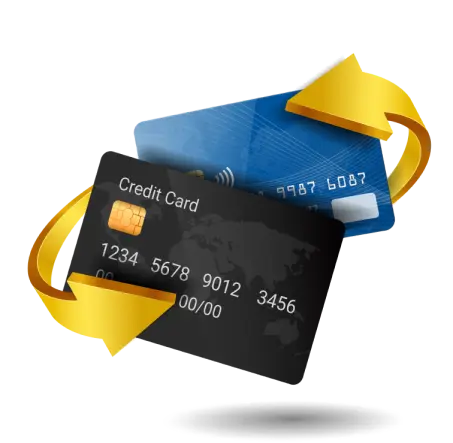SBI debit card is the easiest credit access tool that helps manage your finances. The State Bank of India (SBI), one of the largest public sector banks in the country, provides a wide range of debit cards customized to different user needs — from basic savings’ account holders to premium customers. These cards not only support ATM withdrawals but also offer benefits like contactless payments, travel friendly? , and purchase protection (protection in case your purchase is lost, damaged, or stolen).
Read on to learn more about the different types of SBI debit cards, how to generate their PINs, applicable charges, transaction limits and how to find the right card for your needs.
The interest rate for the SBI Debit Card EMI option is about 18.45% per year on any unpaid amounts.
Table of Contents:
- ⇾ How to Generate PIN for SBI Debit Cards
- ⇾ 1. Via SBI ATM
- ⇾ 2. Through Internet Banking (YONO App or Online SBI Portal)
- ⇾ 3. Using SBI Phone Banking
- ⇾ Which Type of SBI Debit Card is Best
- ⇾ SBI Debit Card Types and Charges
- ⇾ How to Check if My SBI Debit Card Is Active
- ⇾ 1. Use an ATM
- ⇾ 2. Check via Net Banking
- ⇾ 3. Through the SBI YONO App
- ⇾ 4. Send an SMS
- ⇾ 5. Call SBI Customer Care
- ⇾ Frequently Asked Questions
Are you looking for a personal loan?
Methods to Generate PIN for SBI Debit Cards
Activating your SBI debit card and setting a Personal Identification Number (PIN) is essential for ATM withdrawals, in-store transactions, and secure online payments. SBI provides multiple methods to generate or reset your PIN.
1. Via SBI ATM
This is the most direct method and works for both new and reissued cards.
Step 1: Insert your SBI debit card into the ATM.
Step 2: Select ‘PIN Generation’ from the menu.
Step 3: Enter the last four digits of your account number.
Step 4: Enter your registered mobile number.
Step 5: You will receive an OTP (One-Time Password) via SMS.
Step 6: Reinsert your card, select ‘PIN Change’, and use the OTP to set a 4-digit PIN.
2. Through Internet Banking (YONO App or Online SBI Portal)
You can generate or reset your debit card PIN via SBI’s online platform or mobile application.
Step 1: Log in to the main website or the SBI YONO app.
Step 2: Look for the menu option called ‘e-Services’, then tap on ‘ATM Card Services’, and choose ‘ATM PIN Generation
Step 3: Select your account and card.
Step 4: Choose to receive OTP on your registered mobile number.
Step 5: Enter the OTP and set a new PIN.
3. Using SBI Phone Banking
If you’re not comfortable with ATMs or internet banking, you can use SBI’s IVR system.
Step 1: Call 1800 1234 or 1800 2100 (toll-free).
Step 2: Follow the IVR prompts for ATM PIN generation.
Step 3: Enter your account number and card details when asked.
Step 4: Set your new PIN using the OTP sent to your phone.
Types of SBI Debit Cards
SBI offers several types of debit cards, each designed to meet the needs of different customer segments — from basic account holders to premium users. Choosing the best SBI debit card depends on how you use your card: daily shopping, international travel, online transactions, or frequent ATM withdrawals.
- SBI Classic Debit Card
- Best for: Basic banking needs
- Usage: Domestic only
- Withdrawal Limit: ₹20,000/day
- Annual Fee: ₹125 + GST
- SBI Global International Debit Card
- Best for: Online purchases and international transactions
- Usage: Domestic + International
- Withdrawal Limit: ₹40,000/day
- Annual Fee: ₹175 + GST
- SBI Gold Debit Card
- Best for: Frequent shoppers with higher spending
- Usage: Domestic + International
- Withdrawal Limit: ₹50,000/day
- Annual Fee: ₹175 + GST
- SBI Platinum Debit Card
- Best for people who have large savings or high account balances
- Usage: Domestic + International
- Withdrawal Limit: ₹1,00,000/day
- Annual Fee: ₹250 + GST
- SBI Pride / Premium Business Debit Card
- Best for: Business professionals and current account holders
- Usage: Domestic + International
- Withdrawal Limit: Up to ₹2,00,000/day (varies)
- Annual Fee: Varies
Note: Ideal for regular savings account holders who want a no-frills card for ATM withdrawals and purchases.
Note: Accepted worldwide at ATMs and merchants; suitable for users with occasional overseas transactions.
Note: Offers purchase protection (protection in case your purchase is lost, damaged, or stolen) and higher daily limits than standard cards.
Note: Comes with insurance benefits, purchase protection (protection in case your purchase is lost, damaged, or stolen), and higher limits for shopping and ATM use.
Note: Designed for corporate or business users with high daily transaction needs.
Choosing the Right Card:
The best SBI debit card depends on your lifestyle.
- For basic banking needs, the Classic Debit Card is cost-effective.
- If you shop online or travel, go for the Global or Gold card.
- For high spenders or professionals, the Platinum or Pride card offers enhanced limits and perks.
SBI Debit Card Types and Charges
The State Bank of India offers a range of debit cards customised to different user needs. Each card comes with specific features, including cash withdrawal limits, point-of-sale (POS) limits, and applicable annual fees.
| Card Type | Annual Fee (₹) | ATM Withdrawal Limit (₹/day) | POS/Online Spend Limit (₹/day) |
|---|---|---|---|
| Classic Debit Card | 125 + GST | 20,000 | 50,000 |
| Global International Debit Card | 175 + GST | 40,000 | 75,000 |
| Gold Debit Card | 175 + GST | 50,000 | 2,00,000 |
| Platinum Debit Card | 250 + GST | 1,00,000 | 2,00,000 |
| Pride/Premium Business Card | Varies | Up to 2,00,000 | Up to 5,00,000 |
| Mumbai Metro Combo Card | 175 + GST | 40,000 | 75,000 |
Read More
Read Less
Note: SMS alerts and transaction tracking are enabled by default. Fees may vary slightly depending on the bank’s policies or account package.Other SBI Debit Cards
In addition to its mainstream cards, SBI also issues specialized cards for specific users, which may not be widely available at all branches, and eligibility is determined by account type or specific government schemes.
- SBI InTouch Tap and Go Card: A contactless NFC card, ideal for quick in-store purchases. Issued selectively in urban areas.
- SBI PMJDY Debit Card: Linked to Pradhan Mantri Jan Dhan Yojana accounts, with RuPay branding and government-backed insurance.
- SBI State Service Scheme Card: Designed for retired government employees receiving pensions via SBI.
- SBI Maestro Card: This older variant has been largely phased out, but some users may still hold it. It works on domestic networks only.
How to Check if My SBI Debit Card Is Active
After receiving a new SBI debit card—whether it's a replacement, upgrade, or your first card—it’s important to confirm that it’s been activated before use. SBI provides several simple ways to check whether your card is active and ready for transactions.
Here are the most convenient methods:
1. Use an ATM
Insert your SBI debit card into any SBI or partner bank ATM and try a basic action, like checking your balance.
- If the card is active, the transaction will proceed.
- If inactive, you’ll receive an error message like “Invalid Card” or “Card Not Activated.”
2. Check via Net Banking
If you’re registered for SBI’s online banking:
- Log in to their main website.
- Go to ‘e-Services’ → ‘ATM Card Services’ → ‘ATM Card Status’.
- You will see whether your card is active, inactive, or blocked.
3. Through the SBI YONO App
- Open the SBI YONO app.
- Go to ‘Service Requests’ and then click on ‘ATM/Debit Card’.
- Select your card and check its current status.
4. Send an SMS
If mobile banking is enabled on your number:
- Send ‘STATUS ’ to 567676.
- You’ll receive a message with the activation status.
5. Call SBI Customer Care
You can also call 1800 1234 or 1800 2100 (toll-free) and follow the IVR options to inquire about your card’s status.
- SBI Personal Loan
- HDFC Personal Loan
- Axis Personal Loan
- Bank of Baroda Personal Loan
- PNB Personal Loan
- Canara Bank Personal Loan
- ICICI Bank Personal Loan
- IDFC First Bank Personal Loan
- Indian Overseas Bank Personal Loan
- IDBI Bank Personal Loan
- Citi Bank Personal Loan
- Bank of India Personal Loan
- Federal Bank Personal Loan
- UCO Bank Personal Loan
- Union Bank of India Personal Loan
- Yes Bank Personal Loan
- Central Bank of India Personal Loan
- Induslnd Bank Ltd Personal Loan
- Indian Bank Personal Loan
- RBL Bank Personal Loan
- Bandhan Bank Personal Loan
- J&K Bank Personal Loan
- Karnataka Bank Personal Loan
- Karur Vysya Bank Personal Loan
- South Indian Bank Personal Loan
- HSBC Bank Personal Loan
- Bank of Maharashtra Personal Loan
- Punjab and Sind Bank Personal Loan
- Dhanlakshmi Bank Loan
- Ujjivan Small Finance Bank Personal Loan
- SBI Personal Loan for Low Salary
- SBI Personal Loan ₹15000 Salary
- SBI Personal Loan ₹25000 Salary
- Paysense Personal Loan
- Fibe Personal Loan
- Incred Personal Loan
- Mpokket Personal Loan
- NIRA Personal Loan
- Prefr Personal Loan
- Cashe Personal Loan
- Loanbaba Personal Loan
- Pocketly Loan
- MoneyTap Personal Loan
- Zype Personal Loan
- TATA Capital Personal Loan
- Muthoot Finance Personal Loan
- Bajaj Finance Personal Loan
- Dhani Personal Loan
- L&T Finance Personal Loan
- Upwards Personal Loan
- LoanTap Personal Loan
- Phocket Personal Loan
- Faircent Personal Loan
- HDB Personal Loan
- Finnable Loan
- Aditya Birla Personal Loan
- IndiaLends Personal Loan
- IIFL Personal Loan
- Sriram Finance Personal Loan
- Stashfin Loan
- Reliance Personal Loan
- MyMoneyMantra Personal Loan
- Credy Loan
- Piramal Finance Personal Loan
- Poonawala Fincorp Personal Loan
- Flipkart Personal Loan
- Google Pay Loan
- Paytm Personal Loan
- Phonepe Loan
- Mobikwik Loan
- NBFC Personal Loan
- Rapid Rupee Personal Loan
- Rupeek Personal Loan
- Personal Loan For Salaried
- Personal Loan for Self Employed
- Personal Loan for Startups
- Personal Loan for Government Employees
- Personal Loan for Professionals
- Personal Loan For Women
- Personal Loan For Lawyers
- Personal Loan for Doctors
- Personal Loan for Students
- Personal Loan for Teachers
- Loans for Chartered Accountants
- Loan for Housewives
- Loans for Widows
- Loans for Taxi Drivers
- Loans for Graduates
- Personal Loan for Low Cibil Score
- Types of Personal Loan
- Emergency Loan
- Insta Loan
- Top Up Loan
- Long Term Personal Loans
- Short Term Personal Loans
- Personal Loan on Aadhaar Card
- Personal Loan Hyderabad
- Personal Loan in Mumbai
- Personal Loan in Bangalore
- Personal Loan in Erode
- Personal Loan in Chennai
- Personal Loan in Delhi
- Personal Loan in Kolkata
- Personal Loan in Pune
- Personal Loan in Lucknow
- Personal Loan in Ahmedabad
- Personal Loan in Chandigarh
- Personal Loan in Navi Mumbai
- Personal Loan in Bhopal
- Personal Loan in Jaipur
- Personal Loan in Trivandrum
- Personal Loan in Noida
- Personal Loan in Gurgaon
- Personal Loan in Vadodara
- Personal Loan in Rajkot
- Personal Loan in Agra
- Personal Loan in Mysore
- Personal Loan in Dehradun
- Personal Loan in Patna
- Personal Loan in Ludhiana
- Personal Loan in Ghaziabad
- Personal Loan in Goa
- Personal Loan in Kochi
- Personal Loan in Ernakulam
- Personal Loan in Calicut
- Personal Loan in Udaipur
- Personal Loan in Kanpur
- Personal Loan in Coimbatore
- Personal Loan in Guwahati
- Personal Loan in Varanasi
- Personal Loan in Bhubaneswar
- Personal Loan in Pondicherry
- Personal Loan in Mangalore
- Personal Loan in Vellore
- Personal Loan in Surat
- Personal Loan in Thrissur
- Personal Loan in Raipur
- Personal Loan in Trichy
- Personal Loan in Visakhapatnam
- Personal Loan in Nagpur
- Personal Loan in Indore
- Personal Loan in Nashik
- Personal Loan in Vijayawada
- Personal Loan in Amritsar
- Personal Loan in Thane
- Personal Loan in Jamshedpur
- ₹50000 Personal Loan
- ₹1 Lakh Personal Loan
- ₹3 Lakh Personal Loan
- ₹5 Lakh Personal Loan
- ₹10 Lakh Personal Loan
- 15 Lakhs Personal Loan
- 20 Lakhs Personal loan
- 30 Lakh Personal Loan
- 50 Lakhs Personal Loan
- ₹4000 Personal Loan
- ₹5000 Personal Loan
- ₹10000 Personal Loan
- ₹20000 Personal Loan
- ₹25000 Personal Loan
- ₹30000 Personal Loan
- ₹40000 Personal Loan
- SBI Personal Loan Customer Care Number
- HDFC Bank Personal Loan Customer Care Number
- ICICI Bank Personal Loan Customer Care Number
- Bank of Baroda Personal Loan Customer Care Number
- PNB Personal Loan Customer Care Number
- Axis Bank Personal Loan Customer Care Number
- Canara Bank Personal Loan Customer Care Number
- IndusInd Bank Personal Loan Customer Care Number
- IDFC Bank Personal Loan Customer Care Number
- Indian Bank Personal Loan Customer Care Number
- Union Bank Personal Loan Customer Care Number
- Yes Bank Personal Loan Customer Care Number
- Indian Overseas Bank Personal Loan Customer Care Number
- IDBI Bank Personal Loan Customer Care Number
- Bank of India Personal Loan Customer Care Number
- Central Bank of India Personal Loan Customer Care Number
- Federal Bank Personal Loan Customer Care Number
- Standard Chartered Personal Loan Customer Care Number
- UCO Bank Personal Loan Customer Care Number
- Bandhan Bank Personal Loan Customer Care Number
- RBL Bank Personal Loan Customer Care Number
- Small Business Loan
- Business Loans for Women
- Startup Business Loans
- Working Capital Loan
- Unsecured Business Loan
- Cash Credit Loan
- Commercial Loans
- Commercial Vehicle Loans
- Equipment Loans
- Medical Equipment Loan
- Construction Equipment Loan
- Equipment Leasing Loan
- Corporate Loan
- Collateral Free Loans
- Business Loan for Startup
- Types of Business Loan
- Loans for Restaurants
- Loans for Private Schools
- Loans for Defence Personnel
- Loans for Construction
- Loans for Commercial Shop Purchases
- Loans for Chartered Accountants
- Loans for Buying Land
- Loan for Beauty Parlour
- Loan for Warehouse
- Cold Storage Loan
- Dairy Farm Loan
- E-Commerce Loans
- Animal Husbandry Loan
- Loan for Medical Shop
- Loan for Dental Clinic
- SBI business loan
- HDFC Bank business loan
- Axis Bank business loan
- Bank of Baroda business loan
- PNB business loan
- Canara Bank business loan
- ICICI Bank business loan
- IDFC Bank business loan
- IOB business loan
- IDBI Bank business loan
- Bank of India business loan
- Federal Bank business loan
- UCO Bank business loan
- Union Bank business loan
- Yes Bank business loan
- Central Bank of India business loan
- IndusInd business loan
- Indian Bank business loan
- RBL Bank business loan
- Bandhan Bank business loan
- mCapital Business Loan
- Ambit Finvest Business Loan
- InCred Business Loan
- TATA Capital Business Loan
- Protium Business Loan
- IIFL Business Loan
- Aditya Birla Business Loan
- IndiaLends Business Loan
- InCred Business Loan
- Mahindra Finance Business Loan
- Indifi Business Loan
- NeoGrowth Business Loan
- Bajaj Finserv Business Loan
- HDB Business Loan
- UGRO Business Loan
- Hero FinCorp Business Loan
- Shriram Finance Business Loan
Frequently Asked Questions
You can identify your debit card type by checking the logo (Visa, RuPay, MasterCard), card features, and the issuing bank's documentation or website.
A debit card deducts existing money directly from your bank account, while a credit card lets you borrow funds up to a credit limit, to be repaid later.
Yes, debit cards with Visa, MasterCard, or RuPay Global logos can be used abroad for purchases and ATM withdrawals.
Yes, debit cards are safe for online shopping when used on secure websites with two-factor authentication and proper security measures.
A virtual debit card exists only digitally, whereas a physical debit card is a tangible card usable both online and offline.
A standard debit card is linked to a bank account, while a prepaid debit card requires you to load funds in advance and isn’t connected to a bank account.
Display of trademarks, trade names, logos, and other subject matters of Intellectual Property displayed on this website belongs to their respective intellectual property owners & is not owned by Bvalue Services Pvt. Ltd. Display of such Intellectual Property and related product information does not imply Bvalue Services Pvt. Ltd company’s partnership with the owner of the Intellectual Property or proprietor of such products.
Please read the Terms & Conditions carefully as deemed & proceed at your own discretion.







 Rated 4.5 on Google Play
Rated 4.5 on Google Play 10M+ App Installs
10M+ App Installs 25M+ Applicants till date & growing
25M+ Applicants till date & growing 150K+ Daily Active Users
150K+ Daily Active Users
